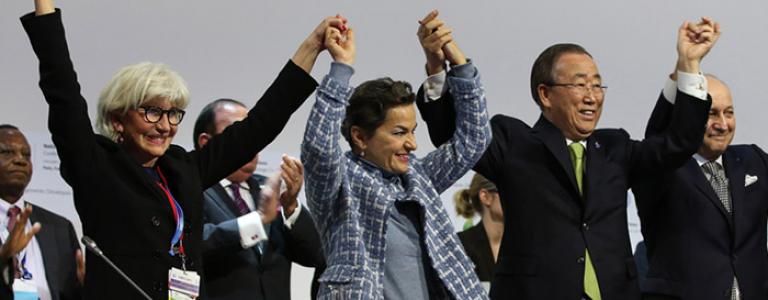The Paris Agreement: Built to last
As the dust begins to settle following the euphoric sense of achievement and relief of UNFCCC delegates during the closing plenary of COP 21 earlier this month, the time has come for a reality check.
As the dust begins to settle following the euphoric sense of achievement and relief of UNFCCC delegates during the closing plenary of COP 21 earlier this month, the time has come for a reality check.
The outcome of COP 21 certainly gives us reason to celebrate. After a decade of negotiations, research and advocacy, the Paris Agreement represents a turning point in our collective effort to tackle climate change. In many ways, it embodies a fresh start and provides a new foundation for climate policy.
Ambition, with many dimensions
The Paris Agreement is legally binding, making its provisions mandatory for Parties under international law. It is virtuous in estabilshing an aspirational goal that sets a clear direction and a facilitative framework to guide countries.
The Agreement is ambitious in that it sets a global goal to keep the increase in global temperature well below 2˚C by 2100 and to pursue efforts to limit it to 1.5˚C. This really is a breakthrough, as it is the most ambitious target ever formalized, and was, for the first time, supported by many developed countries. Parties made the goal more specific by adding a target to achieve global peaking of greenhouse gas emissions as soon as possible, and to reach greenhouse gas emissions neutrality in the second half of this century.
To achieve these goals, countries committed to submit, maintain and frequently review Nationally Determined Contributions (NDCs), which reflect countries’ highest possible ambitions. They have also adopted a resilience goal and agreed to a mechanism to address losses and damages from climate change impacts, giving much more prominence to the need of developing countries to deal with the impacts of climate change than ever before.
Developed countries have also reiterated their commitment to provide support to developing countries. The collective goal of mobilizing USD 100 billion a year in support by 2020 was extended through 2025, with a new, higher goal to be set for the period after 2025. Parties adopted a long-term vision for technology transfer, as well as a new Technology Framework and a Paris Committee for Capacity Building.
All of these achievements demonstrate the fact that Paris represents an ambitious and comprehensive framework for decades to come.
Built to last
The high ambition of the collective global goal, combined with the long-lasting, durable nature of the agreement, sends a strong signal to economic actors that the rules of the game will change. And that chances those changes will be irreversible.
In 1997 in Kyoto, countries also agreed to a legally-binding agreement, but they had agreed to come back to the table eight years later to start negotiating a second round of commitments. By then, the world had changed, as many developed countries have claimed over the past decade and the geopolitics were not right to secure a new set of meaningful and impactful commitments by the Parties.
The Paris Agreement is different; it has been built to last. For instance, it formalizes the role of all countries in reducing emissions and in mobilizing climate finance—in a way that the UN Framework Convention on Climate Change (UNFCCC) did not capture—while also recognizing that developed countries must continue to take the lead. In this sense, the clear division between developed and developing countries that had prevailed is now something of the past.
The Agreement has a number of mechanisms built into it that will ensure it will remain relevant and effective, as realities and circumstances of countries change.
First, countries commit to review NDCs every five years with a commitment that there be a progression in each party’s successive NDC.
Second, mechanisms for all countries to regularly report, review and update emissions information and progress made in implementing their NDCs will allow countries to both keep each other in check and ensure that pathways are consistent with our collective climate goals.
Third, the Agreement also mandates that countries report on and take stock of adaptation efforts as well as of financial support provided every five years. This is a significant recognition that support is needed for developing countries to mitigate emissions and that their needs for support in adaptation are linked to the global level of ambition. In short, the lower the ambition in mitigation is, the higher the needs for adaptation will be.
These three mechanisms will enable us to collectively get our bearings and to ensure not only that countries’ mitigation actions are enhanced over time for emissions to stay on a pathway to emissions neutrality, but also that developing countries receive adequate support to contribute to mitigation and to adapt to climate change.
In a nutshell, Paris sets a clear bearing. It is built to last, but its real impact will depend on political will and governments’ abilities to stay on course.
You might also be interested in
February 2025 | Carbon Minefields Oil and Gas Exploration Monitor
In January 2025, 77 oil and gas exploration licences were awarded in seven different countries, with Norway leading in terms of embodied emissions.
State of the Sector: Critical energy transition minerals for India
This report presents a comprehensive strategy for securing a reliable supply of critical energy transition materials (CETMs) essential to India's clean energy and low-carbon technology initiatives.
Reforming Environmentally Harmful Subsidies
This playbook offers a strategic framework for philanthropic organizations to understand, engage, and advance environmentally harmful subsidies reform as a critical avenue for sustainable environmental and economic transformation.
Fossil Fuel Subsidy Reform in Aviation and Shipping
Countries can address fossil fuel subsidies in aviation and shipping by changing legislation to allow for reform and introducing emission levies.
